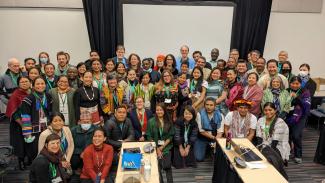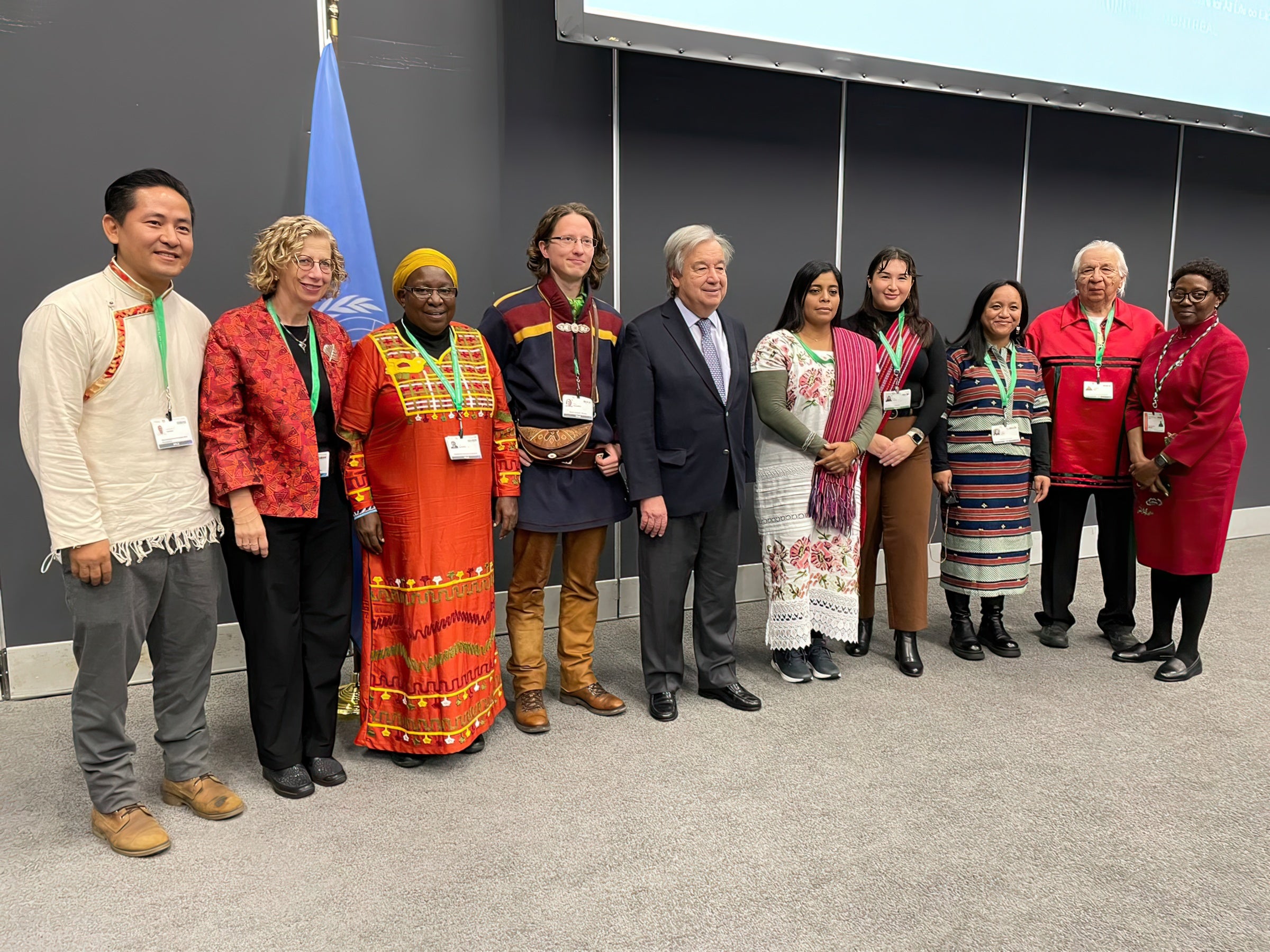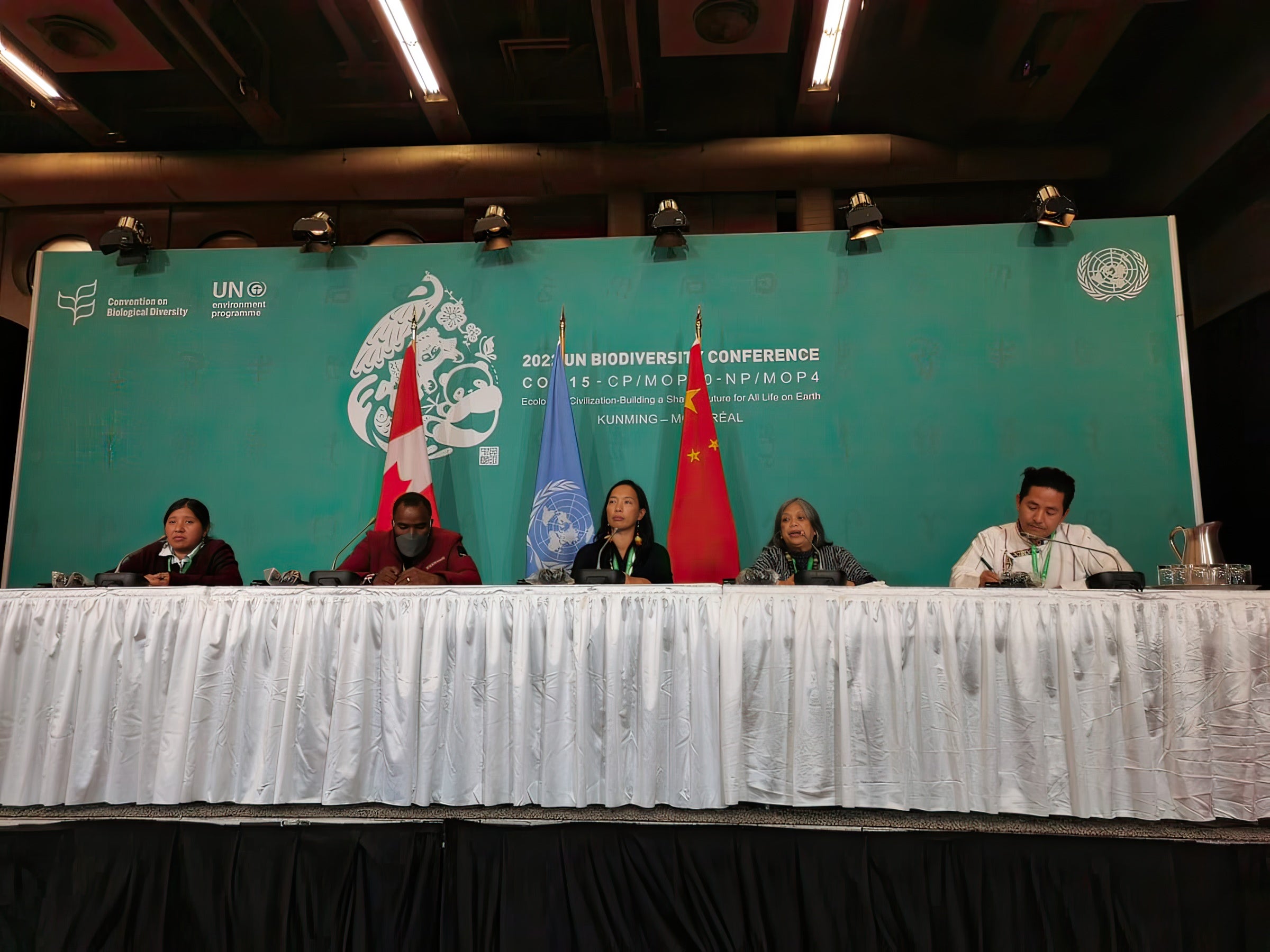
On December 19, 2022, the COP15 presidency adopted the KunmingMontreal Global Biodiversity Framework at the 15th Conference of the Parties to the UN Convention on Biological Diversity (CBD COP15) in Montreal, Canada. It is now a non-binding agreement among 196 nation States who are parties to the UN Convention on Biological Diversity.
For the last four years, many Indigenous delegates worked under the umbrella of the International Indigenous Forum on Biodiversity leading up to the adoption of the Kunming-Montreal Global Biodiversity Framework. It was a collective effort of Indigenous leaders from all seven sociocultural regions of the world, who worked tirelessly to ensure that the newly adopted Global Biodiversity Framework contains 20 references to Indigenous Peoples, 8 references to Traditional Knowledge, 2 references to Free, Prior and Informed Consent, and 1 reference to the UN Declaration on the Rights of Indigenous Peoples throughout the text.
The text acknowledges the contributions and rights of Indigenous Peoples as “custodians of biodiversity and partners in conservation, restoration, and sustainable use.” Furthermore, it calls for Indigenous Peoples’ rights, Traditional Knowledge, worldviews, values, and practices to be respected throughout its implementation, and “full and effective participation in decision-making” of Indigenous Peoples in accordance with the UN Declaration on the Rights of Indigenous Peoples and other international instruments.
The new Framework doesn’t do enough to protect Indigenous Peoples’ rights and territories, however, and uses dangerous terms like “nature-based solutions” in two targets. The use of these terms enables big polluters— the very people responsible for the destruction of the environment—to continue commodifying Mother Earth, and distracts society from true solutions. Indigenous Peoples hold the true solutions for conservation, restoration, and sustainable relationships with biodiversity.

Indigenous leaders meeting with UN Secretary-General António Guterres (center).
Areas of Concern
Target 3, more commonly known as 30x30, relates to the plan to conserve 30 percent of terrestrial, inland water, and coastal and marine areas by 2030. The target refers to “well-connected and equitably governed systems of protected areas and other effective area-based conservation measures, recognizing Indigenous and traditional territories, where applicable.” At a glance, it would appear that Indigenous Peoples have been recognized in this target. However, the language adopted in the text of the target opens room for interpretation on national levels in ways that could be detrimental for Indigenous Peoples. Who will “recognize” and where is it “applicable”? Defining these terms will remain the prerogative of national governments that have historically marginalized, displaced, and annihilated Indigenous Peoples.
Initially, Indigenous representatives recommended officially recognizing Indigenous territories as a third category of area-based conservation (along with Protected Areas and Other Effective Area-based Conservation Measures). Identifying Indigenous and traditional territories as a separate category would have strengthened Indigenous Peoples’ self-determination over the decisions being made about their territories, including those related to conservation measures. Historically, conservation schemes have resulted in fortress conservation, harassment, and displacement of Indigenous communities, and many Indigenous leaders have expressed their concern over this plan becoming yet another land grab if the rights and governance of Indigenous Peoples are not adequately recognized. However, towards the end of the negotiations, the words “recognizing” on the front end and “where applicable” after “Indigenous and traditional territories” were introduced to dilute the language and it was adopted as such.
Target 15, which is related to monitoring, assessment, disclosure, and reporting of businesses’ impacts on biodiversity, has been an area of concern since the negotiations for the Global Biodiversity Framework began four years ago, specifically related to the omission of reporting of impacts on human rights in the text. The current target permits voluntary self-reporting and fails to offer proper regulatory and redress mechanisms that would ensure that companies monitor, evaluate, and disclose information about their impact on biodiversity. Government and third party oversight is essential to regulate and ensure accountability of business impacts on biodiversity. Any financial flows impacting biodiversity and the lands, territories, traditional lifeways, and well being of Indigenous Peoples must be subject to reporting and fully measurable, both qualitatively and quantitatively. Reporting and responsibility of businesses must include restoration of disturbed territories and ecosystems, accounting of collateral and deferred damage, payment of fines and compensations, and prevention and resolution of Indigenous human rights violations and other conflicts that arise.
Removal of Gender Inclusive Language
Language acknowledging gender diversity was deleted from the text of the Gender Plan of Action, one of the plans approved by COP15, at the proposal of Malaysia, Algeria, Bahrain, Saudi Arabia, and the United Arab Emirates, and supported by The Holy See (the Vatican) even though this last entity is not a party to the Convention. The deleted text recognized genders “in all their diversity” and “sexual orientation” and “gender identity.” Some States strongly opposed removing these references, but they compromised to get the plan approved. The deletion sends a violent message to the millions of 2SLGBTQ+ people living under oppressive regimes and in situations of prejudice and harassment. States need to uphold their human rights commitments and ensure that all Peoples are acknowledged and their rights protected in any decisions made at global and national levels.

International Indigenous Forum on Biodiversity’s press conference at COP15. Photo by Cultural Survival.
Resource Mobilization
Parties agreed to establish a new Global Biodiversity Framework Fund, which is supposed to provide the resources needed to achieve the new Global Biodiversity Framework’s 2030 global targets and the 2050 vision, however, it will still operate under the supervision of the Global Environmental Fund. The Global Environmental Fund has been exceptionally slow to meet the challenge of biodiversity loss, and the bureaucratic processes required for Indigenous Peoples to access funds deter grassroots efforts. The Global Environmental Fund will need significant reform to be able to deliver on its mandate. Direct and equitable access to financial resources for Indigenous Peoples is fundamental. Indigenous Peoples must be able to manage funding as full and equal partners in biodiversity conservation.
Notable Positive Developments
Decision 15/9 calls for the fair and equitable sharing of the monetary and non-monetary benefits from the utilization of genetic resources, Digital Sequence Information on genetic resources, and Traditional Knowledge associated with genetic resources with Indigenous Peoples, and that the benefits arising from it should support conservation, sustainable use of biodiversity, and Indigenous Peoples in particular. The agreement establishes a new Multilateral Mechanism of Benefit-Sharing, including a global fund. Indigenous Peoples must remain vigilant as negotiations continue in the lead up to COP16, to be held in late 2023 in Ankara, Turkey.
Targets 5 and 9 address the need for respecting and protecting the customary sustainable use of “wild species” by Indigenous Peoples. This is important, since in many parts of the world Indigenous Peoples are attacked and prosecuted for engaging in customary use of natural resources in their own territories when these happen to overlap with protected areas. States are now required to reform their laws and recognize the customary sustainable use of wild species by Indigenous Peoples.
Target 22 calls for decision-making to be done fully and equitably, “respecting the cultures and rights over lands, territories, resources, and Traditional Knowledge of Indigenous Peoples” with “a gender-responsive approach” and with the participation of women and girls, young people, and people with disabilities. Furthermore, it calls for the “full protection of environmental human rights defenders.” The recognition of environmental human rights defenders is groundbreaking, and should be the start of discussions at national levels to develop more robust laws and policies for their protection.
Finally, the battle for the implementation of the Global Biodiversity Framework will be fought at the national and local levels. States should immediately start reforming their laws to ensure meaningful progress on biodiversity protection and respect for the rights of Indigenous Peoples over their lands and territories. State governments are called to fulfill their obligations to respect, protect, and uphold the rights of Indigenous Peoples and to engage with Indigenous Peoples on the implementation of the Global Biodiversity Framework in good faith. Cultural Survival recognizes the limitations of the framework and urges Indigenous Peoples and our allies to remain vigilant and work together to ensure that the new Global Biodiversity Framework does not result in yet another wave of commodification of Mother Earth.
KUNMING-MONTREAL GLOBAL GOALS FOR 2050
GOAL A
The integrity, connectivity, and resilience of all ecosystems are maintained, enhanced, or restored, substantially increasing the area of natural ecosystems by 2050; Human induced extinction of known threatened species is halted, and, by 2050, extinction rate and risk of all species are reduced tenfold and the abundance of native wild species is increased to healthy and resilient levels; The genetic diversity within populations of wild and domesticated species is maintained, safeguarding their adaptive potential.
GOAL B
Biodiversity is sustainably used and managed and nature’s contributions to people, including ecosystem functions and services, are valued, maintained, and enhanced, with those currently in decline being restored, supporting the achievement of sustainable development for the benefit of present and future generations by 2050.
GOAL C
The monetary and non-monetary benefits from the utilization of genetic resources, and Digital Sequence Information on genetic resources, and of Traditional Knowledge associated with genetic resources, as applicable, are shared fairly and equitably, including, as appropriate with Indigenous Peoples and local communities, and substantially increased by 2050, while ensuring Traditional Knowledge associated with genetic resources is appropriately protected, thereby contributing to the conservation and sustainable use of biodiversity, in accordance with internationally agreed access and benefit-sharing instruments.
GOAL D
Adequate means of implementation, including financial resources, capacity-building, technical and scientific cooperation, and access to and transfer of technology to fully implement the Kunming-Montreal Global Bio- diversity Framework are secured and equitably accessible to all parties, especially developing countries, in particular the least developed countries and small island developing states, as well as countries with economies in transition, progressively closing the biodiversity finance gap of $700 billion per year and aligning financial flows with the Kunming-Montreal Global Biodiversity Framework and the 2050 Vision for Biodiversity.
